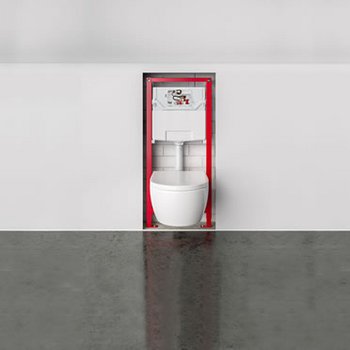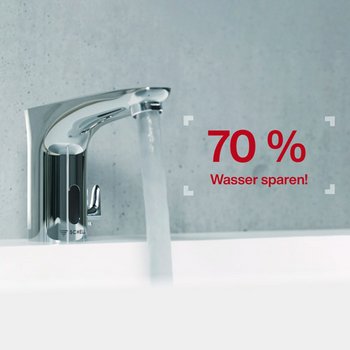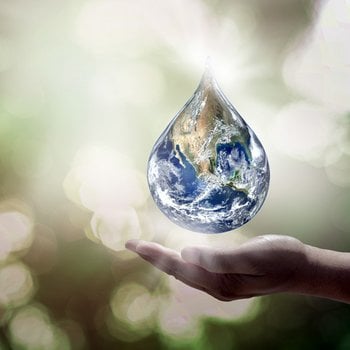Water treatment: how untreated water is turned into drinking water
6-minute read
Water treatment standards in Germany go a long way to explaining the excellent quality of tap water that we enjoy here. August is Water Quality Month, which has been organised to remind us that this quality is by no means self-evident. So how does water become drinking water?

A wealth of water sources
In Germany, drinking water is taken from a number of different sources. Depending on the references consulted, roughly 65 percent comes from groundwater and up to 35 percent from natural springs or open bodies of water. The last category refers to water on the Earth’s surface, whether in the form of lakes, river dams or rainwater run-off. These kinds of sources are used if not enough water can be provided from groundwater. The exact composition of our drinking water can therefore vary considerably from region to region. But whether taken from groundwater or surface water, this untreated water must be properly treated before it can be used as drinking water.
From untreated water to safe drinking water
According to the Federal Ministry for the Environment, Nature Conservation and Nuclear Safety (BMU), around a quarter of untreated water taken from the natural water cycle can be considered as safe drinking water without further treatment. The other three-quarters has to undergo more or less complex treatment processes at the water utility, however. Left untreated, this water could present a health hazard to humans, for example, since it contains contaminants and bacteria. Levels of minerals such as iron and manganese are also often high in untreated water, and can cause an unattractive brownish colouration. Any carbonic acid in the water could also cause damage to piping and lead to corrosion. Water treatment processes enable the removal of these kinds of harmful substances while ensuring that the water is microbiologically safe.

Water safety in Germany – the Drinking Water Ordinance
The overall aim of water treatment is to protect human health, and avoid damage to piping and other components that have contact with water. This involves meeting the quality requirements from the Drinking Water Ordinance. However, this legislation doesn’t merely cover water treatment but also applies to the maintenance of drinking water hygiene in buildings. Optimum support for maintaining water quality here can be offered by SCHELL products. From electronic fittings to the SWS Water Management System or the SMART.SWS online service, SCHELL solutions offer a range of innovative features, such as options for configuring, monitoring and logging stagnation flushes, to ensure that the treated water from the utility continues to be of a high quality even after it has entered the building.
Who is responsible for water treatment – and how is it done?
According to figures from the BMU, there are around 6,200 water utility companies in Germany, who are also responsible for water treatment. The process involves passing the untreated water through a multi-layered cleaning system that removes impurities. This process differs widely depending on the region and the composition of the water. Some utilities will use a natural treatment stage such as aeration, for example. This enriches the water with oxygen, which makes it easier to filter out any iron or manganese that is present in the water. ‘Flocculation’ methods can also be used, for example: these methods involve removing insoluble substances from the water by adding flocculation agents. In the sedimentation stage that follows, these substances settle down onto the floor of the tank. Sand, gravel or carbon filters can also filter dissolved constituents like bacteria or chemicals out of the water. If there are hygienic problems with the water, the treatment process may be followed by disinfection. Chlorine dioxide may be added, for example, to ensure that the water output is microbiologically safe.

Drinking water hygiene to the service connection – and beyond
Thanks to this complex process of treatment, regular lab analysis of the source water used by the water utility and government monitoring of the quality of natural bodies of water, superb water quality is guaranteed right up to the service connection. At the point the water enters the building, the facility manager is then responsible for maintaining drinking water hygiene. Strict regulations must be followed. For more information on drinking water hygiene and how to handle interruptions in use, readers can check out this post or consult the SWS Manual (page 30 ff.). Thanks to the observance of strict guidelines during the journey of the untreated water in the reservoir to the drinking water in our kitchens, tap water in Germany can be enjoyed in the truest sense of the word.

![[Translate to English:] [Translate to English:]](/fileadmin/_processed_/1/b/csm_symstemloesungen_e2_thumb_6bca267f26.jpg)























![[Translate to English:] [Translate to English:]](/fileadmin/user_upload/images/menu/menu_service_downloads_broschueren.jpg)








![[Translate to English:] [Translate to English:]](/fileadmin/_processed_/7/7/csm_menu_unternehmen_ueber-schell_awards_f6cec25b1d.jpg)
![[Translate to English:] [Translate to English:]](/fileadmin/_processed_/a/0/csm_menu_unternehmen_ueber-schell_wasser-sparen_41036d2dd9.jpg)





